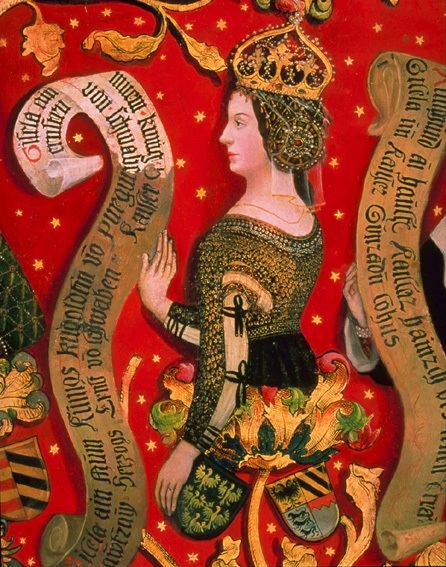Reign 1027–1039 Role Queen of Germany Name Gisela Swabia | Reign 1024–1039 | |
 | ||
Coronation 21 September 1024Cologne Cathedral Issuemore... Liudolf, Margrave of FrisiaErnest II, Duke of SwabiaHerman IV, Duke of SwabiaHenry III, Holy Roman EmperorMatilda of Franconia Died February 14, 1043, Goslar, Germany Children Henry III, Holy Roman Emperor Parents Herman II, Duke of Swabia, Gerberga of Burgundy Similar People Conrad II - Holy Roman E, Henry III - Holy Roman E, Agnes of Poitou, Henry IV - Holy Roman E, Adelaide of Susa | ||
Gisela of Swabia (11 November 990 – 14 February 1043), a member of the Conradiner dynasty, was Queen consort of Germany from 1024 to 1039 and Empress consort of the Holy Roman Empire from 1027 to 1039 by her third marriage with Emperor Conrad II. She was the mother of Emperor Henry III. She was regent of Swavia for her minor son Duke Ernest II of Swabia in 1015.
Contents
Life
Gisela was the daughter of Duke Herman II of Swabia and Gerberga of Burgundy, daughter of King Conrad the Peaceful. Both her parents were descendants of Charlemagne.
She first married the Saxon count Brun I of Brunswick, about 1002. Upon Brun's death, her second marriage was ca. 1012 with the Babenberg scion Ernest, who had been enfeoffed with the Duchy of Swabia by King Henry II at the death of Gisela's brother, Duke Herman III and aimed at legitimising himself as his heir. After Ernest's early death in 1015, Gisela became regent for their minor son Duke Ernest II of Swabia (Herzog Ernst). She was then removed from the regency by her third husband on grounds of her being too closely related to the late Babenberg duke, an incident which later led to a major conflict between Ernest II and his stepfather.
Her third marriage, who took place before January 1017, was to Conrad II, who was elected King of the Romans in 1024 and became Holy Roman Emperor in 1027. According to Thietmar of Merseburg, Archbishop Aribo of Mainz refused to crown her Queen of Germany, as he stated Gisela and Conrad were too closely related. Nevertheless, thirteen days after his coronation, Archbishop Pilgrim of Cologne crowned her instead.
Gisela played an active part in politics, attending Imperial councils and having her uncle King Rudolph III of Burgundy transfer the succession of his Arelat realm to her husband Conrad. Also, she participated in several synods of the church. She took care of her sister Matilda's daughters Sophie and Beatrice, who would both go on to play political roles as Countess of Bar and regent in the Italian March of Tuscany respectively. After Conrad's death in 1039, she and her son Henry III led the mourning progression.
The empress died of dysentery at the Imperial Palace of Goslar in 1043. She is interred in the grotto of Speyer Cathedral, Germany along with several emperors and other members of the imperial family. Her tomb was opened in 1900 and Gisela's mummified body was found to be 172 cm (5' 8") tall, with long blond hair.
Children
Gisela and Brun I, Count of Brunswick had:
Gisela and Ernest I, Duke of Swabia had:
Gisela and Conrad II, Holy Roman Emperor had:
